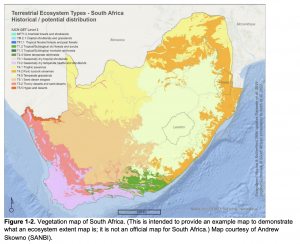EO Support for the Global Biodiversity Framework
In 2024, the CEOS Chair, the Canadian Space Agency (CSA), has chosen to prioritise biodiversity monitoring from space. Over the course of 2024, a series of articles will be published here to support the Chair’s goals, and highlight the importance of Earth observations (EO) for Biodiversity. Please see here for other articles in the series.
The UN CBD Kunming-Montreal Global Biodiversity Framework (GBF) was adopted at the United Nations Convention of Biological Diversity’s (UN CBD) COP-15 in December 2022. The GBF sets out an ambitious pathway to reach the global vision of a world living in harmony with nature by 2050. Integral to the framework are the four overarching, long term goals for 2050 and 23 targets for 2030.
EO can support many of the goals and targets outlined in the GBF. In particular, EO can strongly support Goal A: Protect and Restore, by measuring, monitoring and examining ecosystems across the globe at an unprecedented scale.
The GBF is supported by the Monitoring Framework which outlines the indicators to be used for reporting on progress towards the goals and targets. Space-based Earth observation data can be used to report on many of the 43 GBF headline biodiversity indicators, including Indicator A.2: Extent of natural ecosystems.
Mapping and monitoring the spatial distribution of ecosystems on the Earth, known as ecosystem extent, is one of the most basic needs for natural resource management and especially for conservation efforts—planning a management activity, and assessing its impact, cannot be done without it. Area-based conservation, restoration, and management all require accurate information about ecosystem extent and how it is changing over time.
Space-based EO, i.e. satellite data, are particularly well-suited for mapping and monitoring ecosystems and biodiversity. In particular, the data provided are usually global, periodic, and very often available at no cost to users. These characteristics complement those of in situ observations which provide more detail and at higher accuracy, but are relatively expensive and very irregular in space and time. Consequently, space-based EO have been a critical data source for characterising land use change and ecosystem extent for decades, and more recently to estimate changes in ecological processes that impact biodiversity in those areas.
In 2022, CEOS established an Ecosystem Extent Task Team (EETT) to investigate the use of space-based EO for ecosystem extent mapping. The team’s first major accomplishment was the publication of a white paper in 2023, which aimed to explore and communicate potential new opportunities for using space-based EO for monitoring biodiversity with a focus on ecosystem extent. The white paper provides an excellent analysis of this topic, and can be found here.
Over 2024, the EETT will develop three demonstrator projects to support the white paper. The three projects are:
- Hudson Bay Lowlands, supported by Environment & Climate Change Canada (ECCC)
- Costa Rican Tropical Forests, supported by the French Space Agency (CNES)
- Australian Great Western Woodlands, supported by CSIRO, Australia’s National Science Agency
All three demonstrators are designed around data cube structures and combine data from different sensors. They are using cutting edge research and tools, and each will hopefully be long term projects after the EETT work has concluded. The status and outcomes of these demonstrators will be presented at the 2024 CEOS Plenary in Montreal, Canada, later this year.
CEOS is taking action to ensure space-based EO is used effectively to support indicators such as those identified by the GBF. Over the course of 2024, the CEOS Chair, the Canadian Space Agency (CSA), will discuss these topics with UN CBD, alongside other key organisations such as the UN System for Environmental-Economic Accounting (UN SEEA), the Group on Earth Observations Biodiversity Observation Network (GEO BON) and the Taskforce for Nature-related Financial Disclosures (TNFD). These discussions will culminate at the 2024 CEOS Plenary, which also marks the 40th Anniversary of CEOS.

